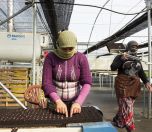Haberin Türkçesi/Kürtçesi için tıklayın
The research was prepared to determine women and girls’ current needs, the difficulties they endure in access to services, and the areas that require to be developed.
The data are acquired by interviewing with 1 thousand 291 Syrian women and girls from provinces of Hatay, Adana, Antep, Urfa, İstanbul, Konya and İzmir.
According to data obtained from the research, prominent points are as follows:
Language barrier
Language barrier is the most important problem in access to other rights and services. Syrians in Turkey are eligible to register in Turkish courses provided free of charge by Turkey but 70 percent of Syrian women don’t speak Turkish at all.
Sheltering problems
Sheltering conditions is a major issue. 36 percent of the interviewed women qualified the houses they live in as bad or very bad; 62 percent as livable (acceptable) and only 2.2 percent as very good.
Education
62 percent of the interviewed are graduates from primary school for having had to give up their education; 19 percent have never gone to school; 21 percent are high-school graduates and only 5 percent have higher education.
Rate of going to school among child participants aged between 6-14 is 61 percent. This rate is dropping in older children (52 percent in aged between 12-14 and 20 percent in aged between 15-17).
Business life
Only 15 percent of the women work at jobs with salary. It came to light that almost half of the women whose spouses died; 36 percent of the divorced women and 32 percent of the single women live with income below 700 TL. (around 100 dollars).
Health and social services
Syrian women are not informed of certain services: 68 percent are not informed of free legal consultancy; 59 percent of psychological support and 57 percent of child care services.
Child labor and child marriage
Child labor is one of the reasons for quitting education life with 19 percent increase in age groups of 6-11 and 12-14.
There is only 3 percent increase in employment rate of girls. This indicated that factors such as child marriage and domestic labor are widespread elements in girls quitting their education life. (BK/TK)








132.jpg)